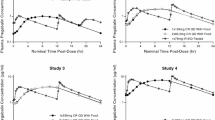Abstract
Background and objective: Metformin is an effective treatment for type 2 diabetes mellitus. The pharmacokinetic characteristics of the conventional immediate-release (IR) formulation of metformin (Glucophage®), however, necessitate two- or three-times-daily dosing. Development of a novel extended-release (XR) formulation of metformin (Glucophage® XR) using GelShield Diffusion System technology provides a once-daily dosing option. The objective of this study was to assess the steady-state pharmacokinetics of metformin XR tablets.
Study design: This was an open-label, multiple-dose, five-regimen, twosequence clinical study lasting 5 weeks.
Methods: Subjects were 16 healthy volunteers aged 18–40 years. Three 1-week regimens of metformin XR (500, 1000 and 1500mg once daily) were administered sequentially. Subjects were alternately given either metformin XR 2000mg once daily or metformin IR 1000mg twice daily during weeks 4 and 5. The pharmacokinetic properties of metformin XR were assessed on two separate days at steady state and compared with those of metformin IR.
Results: Absorption of metformin XR was slower than that of metformin IR (time to maximum plasma concentration = 7 versus 3 hours). Maximum plasma concentrations (Cmax) following the administration of metformin XR 2000mg once daily was 36% higher than that following the evening dose of metformin IR 1000mg twice daily. The extent of absorption, determined by area under the plasma concentration-time curve (AUC), was equivalent for both formulations. The mean accumulation ratio of metformin XR was 1.0, indicating no accumulation with multiple-dose administration. Intrasubject variabilities in Cmax and AUC of metformin were comparable between metformin XR and metformin IR. This novel formulation of metformin XR was well tolerated at single doses up to 2000mg once daily for 7 days, and adverse events were similar to those reported with metformin IR.
Conclusion: The pharmacokinetic parameters of metformin XR tablet using GelShield Diffusion System technology were similar to those of metformin IR. Metformin XR was well tolerated at single doses up to 2000mg once daily.









Similar content being viewed by others
Notes
The use of trade names is for product identification purposes only and does not imply endorsement.
References
Vidon N, Chaussade S, Noel M, et al. Metformin in the digestive tract. Diabetes Res Clin Pract 1988; 4: 223–9
Tucker GT, Casey C, Phillips PJ, et al. Metformin kinetics in healthy subjects and in patients with diabetes mellitus. J Clin Pharmacol 1981; 12: 235–46
Sambol NC, Chiang J, O’Conner M, et al. Pharmacokinetics and pharmacodynamics of metformin in healthy subjects and patients with noninsulin dependent diabetes mellitus. J Clin Pharmacol 1996; 36: 1012–21
Sambol NC, Brookes LG, Chiang J, et al. Food intake and dosage level, but not tablet vs solution dosage form, affect the absorption of metformin HCl in man. Br J Clin Pharmacol 1996; 42: 510–2
Bretnall AE, Clarke GS. Metformin hydrochloride. In: Brittain HG, editor. Analytical profiles of drug substances and excipients. Vol. 25. San Diego (CA): Academic Press, 1998: 243–93
Marathe PH, Wen Y, Norton J, et al. Effect of altered gastric emptying and gastrointestinal motility on metformin absorption. Br J Clin Pharmacol 2000; 50: 325–32
Timmins P, Dennis AB, Vyas KA, inventors. Bristol-Myers Squibb Company, assignee. Biphasic controlled release delivery system for high solubility pharmaceuticals and method. US patent 6,475,521. 2002 Nov 5
Caldwell LJ, Gardener CR, Cargill RC, inventors. Merck and Co, Inc, assignee. Drug delivery device which can be retained in the stomach for a controlled period of time. US patent 4,767,627. 1988 Aug 30
Urquart J, Theeuwes F, inventors. Alza Corporation, assignee. Drug delivery system comprising a reservoir containing a plurality of tiny pills. US patent 4,434,153. 1984 Feb 28
Shell JW, inventor. DepoMed Systems, Inc, assignee. Sustained-release oral drug dosage form. US Patent 5,007,790. 1991 Apr 16
Shell JW, inventor. DepoMed Systems, Inc, assignee. Alkyl-substituted cellulose-based sustained-release oral drug dosage forms. World patent WO 9318755. 1993 Sep 30
Shell JW, inventor. DepoMed Sytems, Inc, assignee. Alkyl-substituted cellulose-based sustained-release oral drug dosage forms. US patent 5,582,837. 1996 Dec 10
Hebden JM, Gilchrist PJ, Blackshaw E, et al. Night-time quiescence and morning activation in the human colon: effect on transit of dispersed and large single unit formulations. Eur J Gastroenterol Hepatol 1999; 11: 1379–85
Glucophage (metformin hydrochloride) and glucophage XR (metformin hydrochloride extended-release tablets) prescribing information. Princeton (NJ): Bristol-Myers Squibb Company, 2002
Data on file, Bristol-Myers Squibb Company, 1998
Di Colo G, Falchi S, Zambito Y. In vitro evaluation of a system for Ph-controlled peroral delivery of metformin. J Control Release 2002; 80: 119–28
Yuen KH, Peh KK, Tan BL. Relating in vitro/in vivo data of two controlled-release metformin formulations. Drug Dev Ind Pharm 1999; 25: 613–8
Pentikainen PJ. Bioavailability of metformin. Comparison of solution, rapidly dissolving tablet, and three sustained-release products. Int J Clin Pharmacol Ther Toxicol 1986; 24: 213–20
Noel DS. Kinetic study of normal and sustained release dosage forms of metformin in normal subjects. J Int Biomed Inform Data 1980; 1: 9–20
Karttunen P, Uusitupa M, Lamminsivu U. The pharmacokinetics of metformin: a comparison of the properties of a rapid-release and a sustained-release preparation. Int J Clin Pharmacol Ther Toxicol 1983; 21: 31–6
Gusler G, Gorsline J, Levy G, et al. Pharmacokinetics of a metformin gastro-retentive tablets in healthy volunteers. J Clin Pharmacol 2001; 41: 655–61
Acknowledgements
Funding for the study was provided by Bristol-Myers Squibb Company, Pharmaceutical Research Institute, Moreton, UK, and Princeton, New Jersey, USA.
Author information
Authors and Affiliations
Corresponding author
Rights and permissions
About this article
Cite this article
Timmins, P., Donahue, S., Meeker, J. et al. Steady-State Pharmacokinetics of a Novel Extended-Release Metformin Formulation. Clin Pharmacokinet 44, 721–729 (2005). https://doi.org/10.2165/00003088-200544070-00004
Published:
Issue Date:
DOI: https://doi.org/10.2165/00003088-200544070-00004




